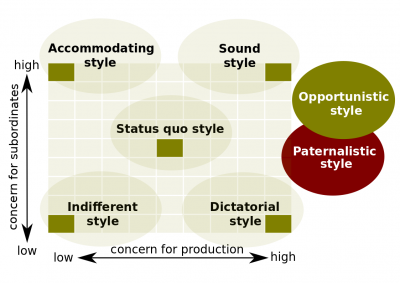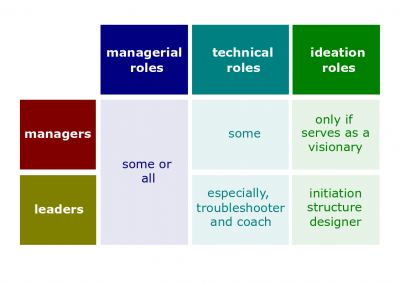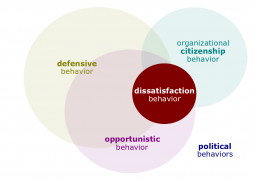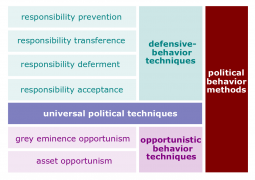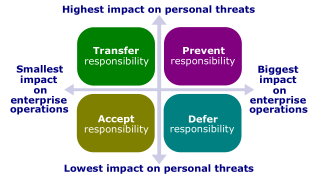OB leadership concepts
OB leadership concepts are those concepts that are related to leadership, power, and political skills researched in organizational behavior studies. The concepts below are taken from Organizational Behavior by Robbins and Judge (17th edition); Septem Artes Administrativi served as the primary source of illustrations.
Contents
Leadership
- Leadership. The ability to influence a group toward the achievement of a vision or set of goals.
- Mentor. A senior employee who sponsors and supports a less-experienced employee, called a protégé.
Leadership in change
- Initiating structure. The extent to which a leader is likely to define and structure his or her role and those of subordinates in the search for goal attainment.
- Vision. A long-term strategy for attaining a goal or goals.
- Vision statement. A formal articulation of an organization's vision or mission.
- Transactional leader. A leader who guides or motivates his or her followers in the direction of established goals by clarifying role and task requirements.
- Transformational leader. A leader who inspires his or her followers to transcend their own self-interests and who is capable of having a profound and extraordinary effect on followers.
Features of leaders
- Consideration. The extent to which a leader is likely to have job relationships characterized by mutual trust, respect for subordinates' ideas, and regard for their feelings.
- Task structure. The degree to which job assignments are procedurized.
- Position power. Influence derived from one's formal structural position in the organization; includes power to hire, fire, discipline, promote, and give salary increases.
- Leader-member relations. The degree of confidence, trust, and respect subordinates have in their leader.
Theories of leadership
- Trait theory of leadership. One of theories that consider personal qualities and characteristics that differentiate leaders from nonleaders.
- Behavioral theories of leadership. One of theories proposing that specific behaviors differentiate leaders from nonleaders.
- Attribution theory of leadership. A leadership theory that says that leadership is merely an attribution that people make about other individuals.
- Charismatic leadership theory. A leadership theory that states that followers make attributions of heroic and extraordinary leadership abilities when they observe certain behaviors.
Leader-member relations
- Path-goal theory. A theory that states that it is the leader's job to assist followers in attaining their goals and to provide the necessary direction and/or support to ensure that their goals are compatible with the overall objectives of the group or organization.
- Leader-participation model. A leadership theory that provides a set of rules to determine the form and amount of participative decision making in different situations.
- Leader-member exchange theory. A theory that supports leaders' creation of ingroups and outgroups; subordinates with ingroup status will have higher performance ratings, less turnover, and greater job satisfaction.
- ==Leadership styles==
- ==Contingency models==
- ==Trust==
- ==Leaderless models==
- ==Power==
- ==Politics==
